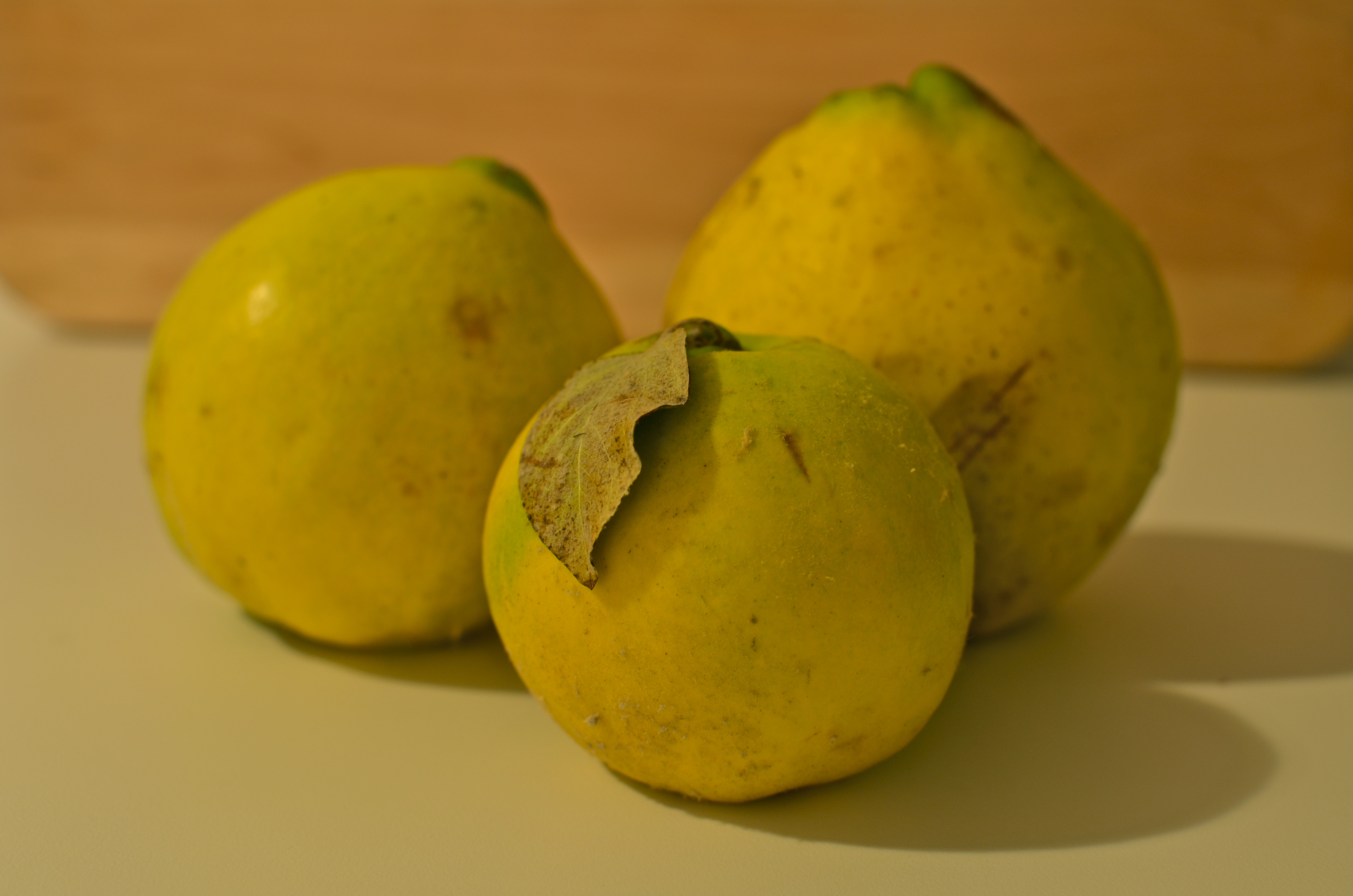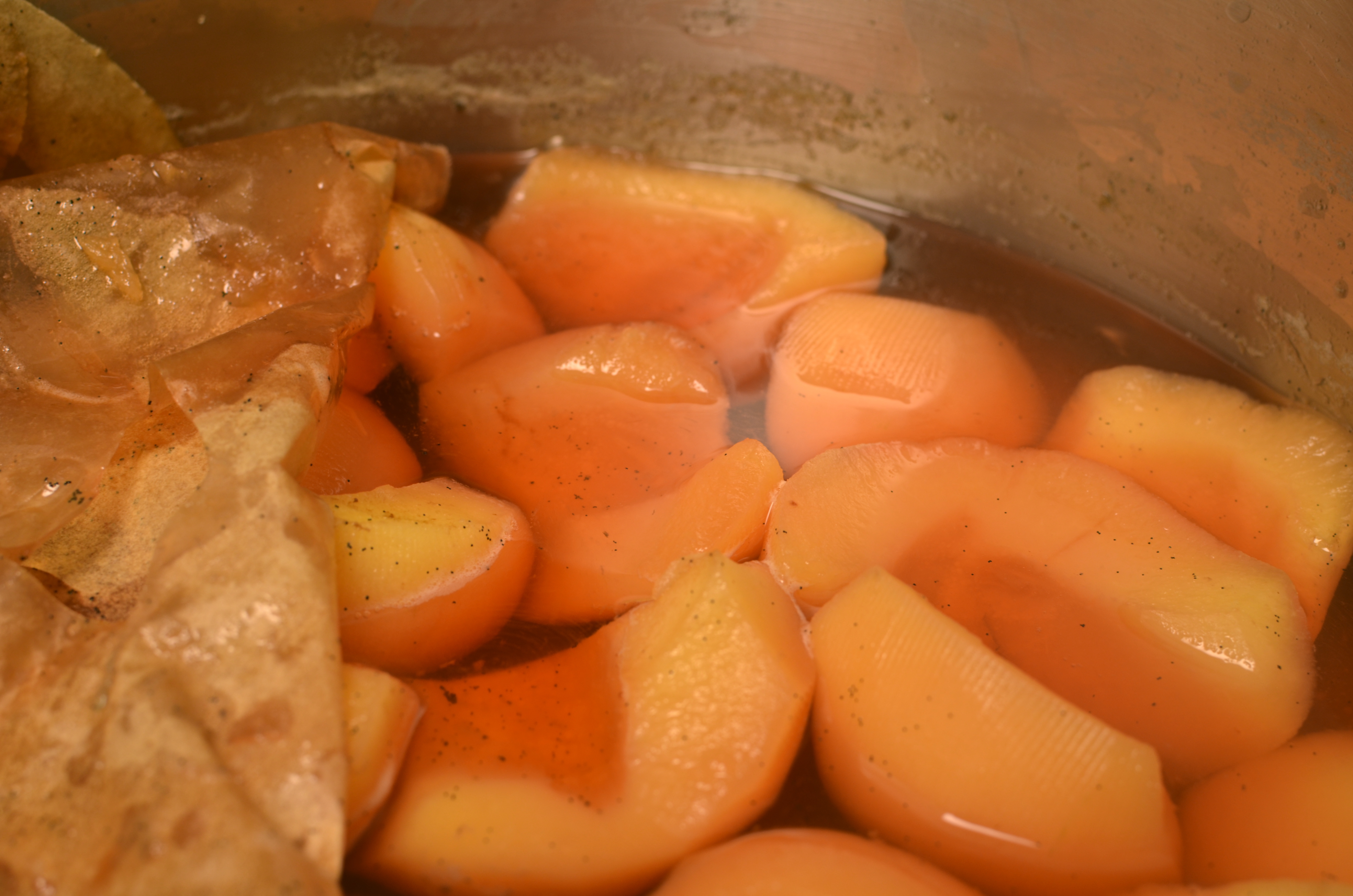
For the first 28 years of my life, a fruit called the quince was a part of my normal diet. Quince are typically found throughout the Mediterranean, and have been a part of its culinary landscape since ancient times. Those of you who paid attention in your Greek Mythology classes might remember the myth of Atalanta. Atalanta was a princess and also incredibly athletic – so athletic, she could run faster than any man. Unhappy with the prospect of being married off, she came up with a plan: she would race her suitors, agreeing to marry the one that out-ran her, but killing all that lost to her. Many men died in their quest to marry Atalanta, but one named Melanion went to Aphrodite for help. The goddess gave him three quince (sometimes referred to as “golden apples”). During his race against Atalanta, whenever he was falling behind, he would drop one quince, and Atalanta – who could not resist the fruit – always stopped to pick the fruit up. Her stops to retrieve the quince gave Melanion the chance to sprint ahead, and he won the race (and her hand in marriage).
There you have it – a fruit so intoxicating, Atalanta was willing to risk her freedom for it. So what is the deal with this fruit? Quince actually cannot be eaten raw – they may look like a cross between an apple and a pear, but they are too hard to bite into, and too tart and acidic to eat. When cooked, however, the quince’s sour, dull yellow flesh becomes a sweet, fragrant, rosy-hued delight.

There is, however, one major problem with quince: they are difficult to find in the U.S. They can be found all over Europe, but not here. My grandparents had quince trees in their backyard in Virginia, and my grandmother would make the most delicious quince preserves from their fruit. When she passed on, her quince preserves went with her, and my source of quince is now gone. I have since learned another hard truth: not only are quince hard to find, most people I meet haven’t even heard of them.
My love of quince – and my frustration in never finding them – is what brought me to David Lebovitz. Mr. Lebovitz was the pastry chef at Chez Panisse in Berkley, CA (a restaurant I visited last summer, and high recommend), and now lives in Paris. He has a number of excellent dessert-centric cookbooks out there, and in both them and on his blog, he talks for his love of quince. I plan on trying his recipe for quince marmalade (hoping, of course, it tastes much like my grandmother’s did) and quince paste, but first I tried an easy recipe for poached quince.
If you’ve never had quince before, I beg you to try this recipe. They are cooked with sugar, honey, lemon and a vanilla bean – a simple mixture that highlights the fruit’s unique flavors. You can eat them as is, or top with vanilla ice cream for a more decadent dessert, or add them to granola for breakfast. They can be added to other desserts, like mixed in with apples and pears in a crisp, or made into a tarte Tatin.
Rosy Poached Quince
Adapted from David Lebovitz (my new hero)
Total time: 1-2 hours
Notes on Quince:
1) Go out and buy quince NOW. They are only in season October and November. You likely won’t find them in a typical grocery store, so visit your local farmer’s market.
2) When choosing quince, lift each up to your nose and smell. A good quince will smell of flowers or vanilla, with a hint of pineapple. If it does not have that pleasant smell, move on to the next. The more yellow the fruit, the more ripe it is (compare the picture above of the yellowish “golden apples” to this one of less ripe green quince). You would ideally like your quince to be more on the yellow-ish side, but you can poach the green ones too and they will turn out great. Most of the quince I used in this recipe were on the greener side. As long as the green fruit smells good, you will be good to go.
3) Once you buy quince, trying letting them sit on your dining table or kitchen counter a few days. Why? Because within an hour of bringing them home, they will fill your room (or your one-bedroom apartment) with the most intoxicating aroma. I can even smell it down the hall when I get off the elevator.
3) Quince are a very hard fruit. Be careful when cutting and coring them, because a slip of the knife is all too easy.
Ingredients
7 cups water
1 cup sugar
1/2 cup honey
1 lemon (preferably organic or unsprayed), cut in half
1 vanilla bean, split lengthwise
6 large, or 8 medium, quince
1. Put the water, sugar, honey, 2 lemon halves, and vanilla bean in a large non-reactive pot and turn it on to medium-to-high heat.
2. While the liquid is heating, peel, quarter, and remove the cores of the quince. Make sure to removed anything tough for fibrous, being very careful with the knife. (Mr. Lebovitz states that the intrepid can wear one of these.)
3. As you peel and prepare the quince quarters, put each one into the simmering liquid. Once they’re all done, cover the pot with a round of parchment paper with a walnut-sized hole cut in the center.
4. Simmer the quince (but do not boil) for at least an hour, until the quince are cooked through. Cooking time will vary, depending on the quince. They are done when they are cooked through, which you can verify by piercing one with the tip of a sharp paring knife. It’s not unusual for them to take up to 2 hours, or more. They will have started to turn a rosy pink, and the quince will turn an almost-neon shade of rosy-pink the longer they sit in their poaching liquid after they have been stored (see the top picture for how pink they get!).
Serve warm, or at room temperature. To store, pour the quince and their liquid into a storage container and refrigerate for up to one week.


This looks wonderful and I really would love to try it. They’re supposed to be common down here, but well I’ll keep looking.
hmm, definitely have never tried quince, nor do i think i have seen them! i’ll certainly keep an eye out now 🙂
Great post! I love mythology 🙂 Quince paste is very common to find in Argentina, as a child we always had some in the fridge. I loved pairing it with cheese, Yum!
Darn it, ME, now I have an early morning craving for quince preserves! That would be so much better than my dry Kashi Go Lean right now.
Ooh, and Ruth, I’m loving the idea of quince and cheese. That would really jazz up a cheese plate.
[…] post by Pâte à Chew Category: Uncategorized You can follow any responses to this entry through the RSS 2.0 feed. […]
I remember quince from Greece especially, but have had them in other European countries as well. Poaching them sounds delicious! I miss the availability of many fruit in the United States, unfortunately.
A friend of mine who is German told me her grandparents had them at their house in Germany. So clearly they are all over Europe, but so hard to find here!
Oh you’re teasing me! I have never seen this fruit even in my most diverse markets (maybe I just haven’t been looking…)
What fascinates me is that when cooked the color and flavors completely change! I would love to try this.
The story was fascinating. I do enjoy “mythology”. Thank you!